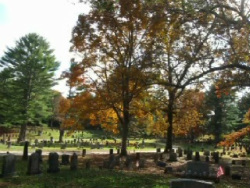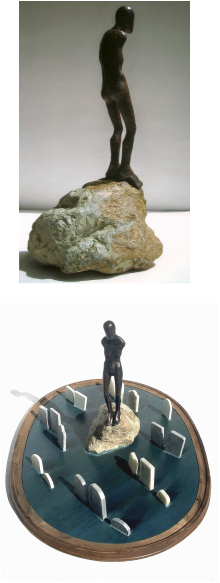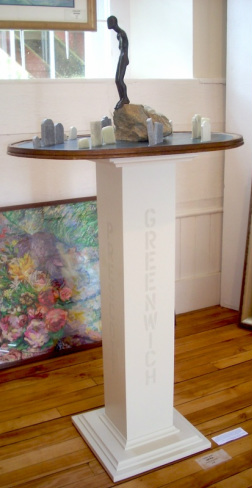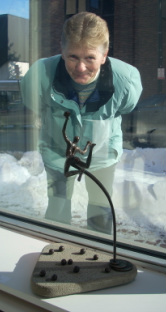
In 2010, playwright Dorothy Johnson approached me about collaborating with her on a presentation for the exhibition of original art and poetry called 'Interface' organized by Massachusetts poet, Candace Curran. Dorothy had written a series of short vignettes about fictional people who might have lived in
the Swift River Valley prior to the creation of the Quabbin Reservoir. The pieces reflect the impact of the flooding of the Valley, the loss of homes and property, and the relocation of over 6500 bodies that were exhumed from local cemeteries and reinterred elsewhere.

Rough hands moved me here
and jostled my bones.
Life was hard enough
that I was glad to come to rest
in Dana where all was quiet.
Why did they move me
to this place?
For me, the anger, frustration and helplessness that must have been felt by all who lost their homes in the Valley was encapsulated in these few words. I had a small unfinished armless bronze figure mounted on a piece of stone that I felt projected these same emotions. This led me to creating a setting for the figure that consisted of a cemetery partly submerged by flowing water. I inserted a piece of thin plywood that had a pronounced "flowing" textured grain into an old oval wooden frame. I cut headstones out of soapstone and arranged them around the centered figure. Then I painted the plywood surface to look like a flowing river and added shadows from the headstones on the "water".

Masschuetts, including the 1794 Meetinghouse in New Salem. After constructing a signpost-like base with the name of the 4 towns flooded to create the reservoir painted on each side, I was able to display the sculpture at several of the presentations to bring our experience
full circle.
* Additional information about A Swift River Anthology, including purchase information, can be found under the 'More' section of the site menu.

 RSS Feed
RSS Feed